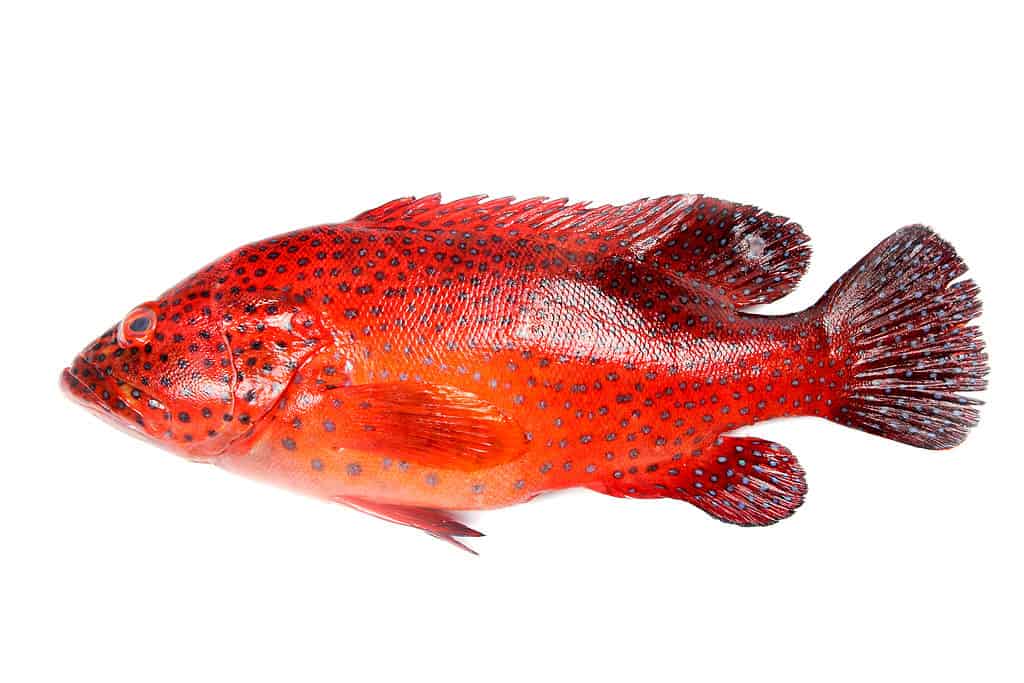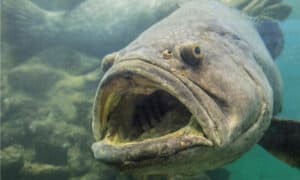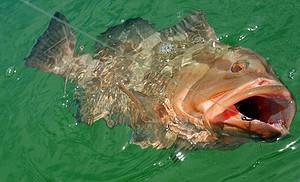People who enjoy fishing as a hobby or profession often draw a lot of pride from capturing the biggest fish—ones likely to go into the record books as the largest ever caught in their respective species. Let’s learn more about the largest red grouper ever caught in Florida, as well as more about this amazing fish species.
The red grouper is among the most coveted fish among anglers, especially in Florida, which attracts fishermen across many regions.
Red groupers, scientifically named Epinephelus morio, are common across various bodies of water in Florida. Their habitats range from rocky ledges to flat-bottom rocky offshore sections. Groupers are rarely found within coral reefs as they prefer regions with thick covers that shield them from predators.
The Oriskany Memorial Reef is one of the most common places to catch red groupers. Also referred to as The Great Carrier Reef, this manmade reef in Pensacola, FL, is a stronghold of red groupers. It offers a thick cover with rocky surfaces, protecting fish from predatory species. The groupers also have enough hunting space to hide and await their prey.
Other parts of Florida where you can find red groupers include the rocky reefs of Fort Lauderdale, Key Biscayne, Miami, St. Augustine Inlet, and the Florida Keys.
What is the Largest Red Grouper Ever Caught in Florida?
The largest red grouper ever caught in Florida weighed 42 pounds, four ounces. Fisherman Del Wiseman Jr. will go down in the history of Florida’s fishing expeditions for catching the largest red grouper in the region. This record was set on March 9, 1997, in the St. Augustine Inlet.
This record remains unbeaten for almost 26 years as of 2023. The International Game Fish Association considers Del Wiseman Jr. the “All-Tackle World Record” holder. The tackler had sailed approximately 46 miles from the shore of St. Augustine Inlet before capturing his coveted red grouper.

The largest red grouper ever caught in Florida weighed 42 pounds, four ounces.
©wanchai/Shutterstock.com
Facts About Red Groupers
The red grouper is a fish species that appears brown-red, inspiring its name. Despite their slow growth, red groupers can grow as long as 50 inches and weigh 50 pounds or more. This fish lives up to 25 years, with its average length reaching 42 inches.
As mentioned, red groupers inhabit hard or rocky surfaces at the bottom-most part of the reef. But younger fish aged 1-6 years old live around shore reefs. Their preferred water temperature ranges from 66-77 degrees Fahrenheit.
One fun fact about red groupers is the female’s ability to go through a sex reversal, transitioning into males as they grow older.
While there are other types of groupers, red groupers make up about 70% of the fish harvest within U.S. waters. This species can be turned into various culinary dishes due to its dense flakes and high oil content. In addition, the fish remains firm and moist when cooked, making it a chef’s favorite in preparing steaks, filets, and whole fish meals.
Offshore spawning of red groupers occurs from January-June, but the spawning season peaks highest in April-May.
Red groupers feed on different invertebrates within the reef. While their main diet consists of snapping shrimps, young spiny lobsters, and portunid crabs, red groupers occasionally feed on various small fish. They are categorized as opportunistic feeders who feed on a variety of marine life across the reefs they inhabit.
Another unique fact about red groupers is their ability to change color patterns when aggravated, especially during spawning. The most notable changes include the intense appearance of white spots. In addition, red groupers’ heads and the rest of their bodies can also turn fully white.
Other Groupers Found in Florida
If you intend to go fishing or angling in Florida, you will be spoiled for choice by the variety of groupers you can target. Due to their large sizes, groupers are often caught for sport, but they also make delicious meals when you’re craving seafood.
Game fishing is common in Florida, with many anglers challenging themselves to catch the largest grouper and break the record of those preceding them in various categories.
Black Groupers
The rare type of grouper is the black grouper as they are more limited and less available than others. You can still find them in various bodies of water in Florida, mainly around reefs and old wrecks.
The common feature distinguishing black groupers from other groupers is their protruding jaws. You can also look out for their gray blotches and note whether they are rectangular.
Meat derived from black groupers is flavorful and delicious. Compared to red groupers, many chefs prefer black groupers because the latter provide more meat. Black groupers also have smaller heads, which increases their popularity in culinary dishes.
Yellowedge Groupers
Yellowedge groupers are also popular in the waters of Florida. The name is derived from the yellow color on the outer edges of this grouper’s anal, pectoral, and dorsal fins. Other parts of their bodies are light brown, giving them a colorful blend that increases their popularity.
Yellowedge groupers often inhabit surfaces approximately 300 feet deep, but you can find a few within deeper coral reefs. They are considered the tastiest species of groupers.
Goliath Groupers
The goliath grouper is the largest of them all. They grow up to eight feet and can weigh about 800 pounds. The current record for the largest goliath grouper ever caught in Florida is 680 pounds. It was caught in 1961 in the Fernandina Beach waters in Florida.
Due to their large size, goliath groupers feed on fishes of smaller sizes, including other groupers. They are also harder to catch because they are a protected grouper species.
Gag Groupers
Another common grouper is the gag grouper. Similar to the red groupers, gag groupers can undergo a sex reversal. For example, female gag groupers may turn male as they age.
Due to their slow growth, gag groupers can be over three feet long. In addition, they weigh as heavy as 50 pounds, extending their lifespan to 30 years.

Groupers like rocky and structural surfaces, such as coral reefs.
©Rich Carey/Shutterstock.com
Places to Discover Groupers in Florida
Florida is well endowed with fresh and salty bodies of water, making it a great spot for angling and professional fishing. In addition, groupers are common in Florida, increasing your chances of capturing at least one type during your fishing expedition.
Check out the following spots for a great experience catching groupers in Florida.
Fort Lauderdale
Whether you are a tourist or local resident looking for a grouper, Fort Lauderdale is a popular spot to start. As you know by now, groupers like rocky and structural surfaces, hence why they’re attracted to this region.
Fort Lauderdale has rocky reefs and many structures that different groupers inhabit. Inhabiting these waters gives the fish a great hiding spot and a variety of prey to hunt. You are almost sure to catch a grouper in the area if you follow the city’s guidelines.
Miami
Many people are familiar with Miami for its great nightlife, parties, and beautiful beaches, but rarely consider it a fishing spot. On the contrary, Miami has a variety of grouper species, ranging from scamp groupers to snowy groupers, among others.
You can increase your chances of catching a grouper by sailing south of Miami Beach to the Key Biscayne waters where these types of fish inhabit the shores in large numbers.
The Florida Keys
As you approach the edge of the Peninsula of Florida, you will find several islands known as the Florida Keys. These waters present wholesome fishing grounds with natural habitats for many fish species to thrive, including groupers.
Pensacola
The largest artificial reef in the world is just offshore of Pensacola, making it the ideal place to locate and catch groupers. The Great Carrier Reef, also known as the Oriskany Memorial Reef, offers groupers a ton of cover from predators, which draws many groupers ready to be caught.
Regulations for Grouper Fishing in Florida
To fish In Florida, you will spend at least $17 to get a three-day license and $30 for a seven-day one. From January 1-April 30, the Atlantic Ocean’s black grouper fishing season is usually closed.
You will most likely need to hire a boat for the day to catch a decent grouper. The necessary documentation, including fishing licenses, should be delivered by your charter company. Before leaving, check Florida’s fishing laws or ask your charter service for more details.
Typical Hiding Places for Groupers
Even though most groupers are found close to shores, they are usually smaller. It must be at least 24 inches long to keep and carry home a grouper. Therefore, you will need to venture offshore and into deeper waters if you seek larger fish.
Be careful since groupers like to “dig,” meaning they dive for cover if they take the bait. Ensure you use the proper gear when fishing for groupers if you do not want your line to break.
What You Need to Know About Red Groupers
The red grouper is a sturdy, medium-sized fish. Its pectoral fins are more extended than pelvic fins. On the body, the pelvic fins are attached posteriorly to the pectoral fins. The base of the red grouper’s smooth dorsal and anal fins are covered in thick skin and scales. There is no saddle on the caudal peduncle and the caudal fin is truncated.
The great size of its dorsal fin and the lack of a notch on the interspinous membrane help distinguish the red grouper from other Epinephelus species, which are occasionally confused with it.
Feeding Habits
Various marine invertebrates, including crabs, shrimp, octopi, and fish, such as snappers and parrotfish, are among the red grouper’s prey. It is well known that the red grouper is particularly vulnerable to red tide poisoning.
Reproduction and Lifespan
Male red groupers are of reproductive significance at around 10 years of age or more, while females attain sexual maturity at around 4-6 years. Red groupers have an estimated 25-30 years lifespan.
All red groupers start as females since this species is a protogynous hermaphrodite. However, between the ages of 7-14, and after reaching a length of at least 23 inches, most females change into males.
The Caribbean Sea and the Mexican Gulf both experience red grouper spawning from January-April.
Groupers let go of their eggs and sperm in offshore water during spawning activities. To stay buoyant, the embryos need high salinity (32 parts per thousand). About 30 hours after spawning, the eggs develop into larvae and swim with ocean currents as zooplankton.
After hatching, larvae leave the zooplankton and move to the substrate at the bottom after around 35-50 days, corresponding to a typical length of 20-25 millimeters. They mainly eat demersal crustaceans that live on seagrass beds as young juveniles. Unfortunately for these young ones, they are prone to attack by predators such as larger fish.
As the larvae get older, they spread out to more gravel bottoms, where they eat a variety of crustaceans and smaller fish. The amount of fish in their diet rises as red groupers get bigger.
Key Takeaways
Visitors and anglers can fish for various red grouper species using different techniques all throughout Florida waters. It is the world’s most varied sportfishing site. As opposed to other sportfishing hotspots, Key West, FL, provides year-round, limitless fishing.
Up Next
- Discover the Largest Grouper Ever Caught
- Animals in Florida
- Discover Florida’s Coldest January on Record
The photo featured at the top of this post is © Andrea Izzotti/Shutterstock.com
Thank you for reading! Have some feedback for us? Contact the AZ Animals editorial team.






